

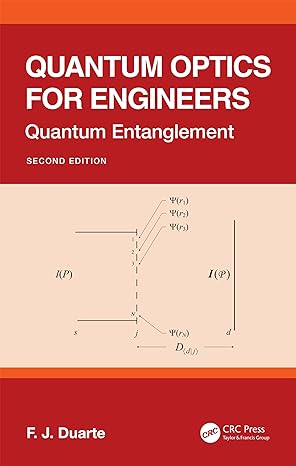 ISBN: 978-1032499345
ISBN: 978-1032499345
Quantum Optics for Engineers: Quantum Entanglement includes: 23 chapters, 11 appendices, 195 figures, more 1400 equations, many worked out examples, more than 150 problems, a large number of archival references, and a comprehensive index, in 403 pages.
1.1 Introduction
1.2 Brief Historical Perspective
1.3 The Principles of Quantum Mechanics
1.4 The Feynman Lectures on Physics
1.5 The Photon
1.6 Quantum Optics
1.7 Quantum Optics for Engineers
1.7.1 Quantum Optics for Engineers 2nd Edition
Problems
References
2.1 Introduction
2.2 Planck’s Equation and Wave Optics
2.3 Planck’s Constant h
2.3.1 Back to E=hv
Problems
References
3.1 Heisenberg’s Uncertainty Principle
3.2 The Wave-Particle Duality
3.3 The Feynman Approximation
3.3.1 Example
3.4 The Interferometric Approximation
3.5 The Minimum Uncertainty Principle
3.6 The Generalized Uncertainty Principle
3.7 Additional Versions of Heisenberg’s Uncertainty Principle
3.7.1 Example
3.8 Applications of the Uncertainty Principle in Optics
3.8.1 Beam Divergence
3.8.2 Beam Divergence in Astronomy
3.8.3 The Uncertainty principle and the Cavity Linewidth Equation
3.8.4 Tuning Laser Microcavities
3.8.5 Nanocavities
Problems
References
4.1 Dirac’s Notation in Optics
4.2 Interferometric Quantum Principles
4.3 Interference and The Interferometric Equation
4.3.1 Examples: Double, Triple, and Quadruple-Slit Interference
4.3.2 Geometry of the N-slit Interferometer
4.3.3 The Diffraction Grating Equation
4.3.4 N-slit Interferometer Experiment
4.4 Coherent and Semi-Coherent Interferograms
4.5 The Interferometric Equation in Two and Three Dimensions
4.6 Classical and Quantum Alternatives
Problems
References
5.1 Introduction
5.2 Interference and Diffraction
5.2.1 Generalized Diffraction
5.2.2 Positive Diffraction
5.3 Positive and Negative Refraction
5.3.1 Focusing
5.4 Reflection
5.5 Succinct Description of Optics
5.6 Quantum Interference and Classical Interference
Problems
References
6.1 Useful Identities
6.1.1 Example
6.2 Linear Operations
6.2.1 Example
6.3 Extension to Indistinguishable Quanta Ensembles
Problems
References
7.1 Interference a la Dirac
7.2 The Hanbury Brown-Twiss Interferometer
7.3 The N-slit Interferometer
7.4 Reflective Interferometers
7.4.1 The Michelson Interferometer
7.4.2 The Sagnac Interferometer
7.4.3 The Mach-Zehnder Interferometer
7.4.4 The HOM Interferometer
7.5 Multiple Beam Interferometers
7.6 The Ramsey Interferometer
Problems
References
8.1 Introduction
8.2 Theory
8.3 N-Slit Interferometer for Secure Free-Space Optical Communications
8.4 Interferometric Characters
8.5 Propagation in Terrestrial Free Space
8.5.1 Clear Air Turbulence
8.6 Further Applications
8.7 Discussion
Problems
References
9.1 Introduction
9.2 A heuristic Explicit Approach to Schrödinger’s Equation
9.3 Schrödinger’s Equation Via Dirac’s Notation
9.4 The Time Independent Schrödinger Equation
9.4.1 Quantized Energy Levels
9.4.2 Semiconductor Emission
9.4.3 Quantum Wells
9.4.4 Quantum Cascade Lasers
9.4.5 Quantum Dots
9.5 Nonlinear Schrödinger Equation
Problems
References
10.1 Introduction
10.2 The Classical Action
10.3 The Quantum Link
10.4 Propagation Though a Slit and the Uncertainty Principle
10.4.1 Discussion
10.5 Feynman Diagrams in Optics
Problems
References
11.1 Introduction
11.2 Introduction to Vector and Matrix Algebra
11.2.1 Vector Algebra
11.2.2 Matrix Algebra
11.2.3 Unitary Matrices
11.3 Pauli Matrices
11.3.1 Pauli Matrices for Spin One-Half Particles
11.3.2 The Tensor Product
11.4 Introduction to the Density Matrix
11.5 Quantum Operators
11.5.1 The Position Operator
11.5.2 The Momentum Operator
11.3.3 Example
11.5.4 The Energy Operator
11.5.5 The Heisenberg Equation of Motion
Problems
References
12.1 Introduction
12.2 Maxwell Equations
12.2.1 Symmetry in Maxwell Equations
12.3 Polarization and Reflection
12.3.1 Plane of Incidence
12.4 Jones Calculus
12.4.1 Example
12.5 Polarizing Prisms
12.5.1 Transmission Efficiency in Multiple-Prism Arrays
12.5.2 Induced Polarization in a Double-Prism Expander
12.5.3 Double-Refraction Polarizers
12.5.4 Attenuation of the Intensity of Laser Beams Using Polarization
12.6 Polarization Rotators
12.6.1 Birefringent Polarization Rotators
12.6.2 Broadband Prismatic Polarization Rotators
12.6.3 Example
Problems
References
13.1 Introduction
13.2 Linear Polarization
13.2.1 Example
13.3 Polarization as a Two State System
13.3.1 Diagonal Polarization
13.3.2 Circular Polarization
13.4 Density Matrix Notation
13.4.1 Stokes Parameters and Pauli Matrices
13.4.2 The Density Matrix and Circular Polarization
13.4.3 Example
Problems
References
14.1 Introduction
14.2 Bell’s theorem
14.3 Quantum Entanglement Probabilities
14.4 Example
14.5 Discussion
Problems
References
15.1 Introduction
15.2 The Dirac-Feynman Probability Amplitude
15.3 The Quantum Entanglement Probability Amplitude
15.4 Identical states of polarization
15.5 Entanglement of Indistinguishable Ensembles
15.6 Discussion
Problems
References
16.1 Introduction
16.2 Quantum Entanglement Probability Amplitude for n = N= 4
16.3 Quantum Entanglement Probability Amplitude for n = N= 8
16.4 Quantum Entanglement Probability Amplitude for n = N= 16
16.5 Quantum Entanglement Probability Amplitude for n = N = 21, 22, 23, …2r
16.5.1 Example
16.6 Summary
Problems
References
17.1 Introduction
17.2 The quantum entanglement probability amplitude for n = N= 3
17.3 The quantum entanglement probability amplitude for n = N= 6
17.4 Discussion
Problems
Reference
18.1 Introduction
18.2 Quantum Entanglement Probability Amplitudes
18.3 Quantum Entanglement Via Pauli Matrices
18.3.1 Example
18.3.2 Pauli Matrices Identities
18.4 Quantum Entanglement Via the Hadamard gate
18.5 Quantum Entanglement Probability Amplitude Matrices
18.6 Quantum Entanglement Polarization Rotator Mathematics
18.7 Quantum Mathematics Via Hadamard’s Gate
18.8 Reversibility in Quantum Mechanics
Problems
References
19.1 Introduction
19.2 Interferometric Computer
19.3 Classical Logic Gates
19.4 von Neumann Entropy
19.5 Qbits
19.6 Quantum Entanglement Via Pauli Matrices
19.7 Rotation of Quantum Entanglement States
19.8 Quantum Gates
19.8.1 Pauli Gates
19.8.2 The Hadamard Gate
19.8.3 The CNOT Gate
19.9 Quantum Entanglement Via the Hadamard Gate
19.9.1 Example
19.10 Multiple Entangled States
19.11 Discussion
Problems
References
20.1 Introduction
20.2 Quantum Cryptography
20.2.1 Bennett and Brassard Cryptography
20.2.2 Quantum Entanglement Cryptography using Bell’s Theorem
20.2.3 All-Quantum Quantum Entanglement Cryptography
20.3 Quantum Teleportation
Problems
References
21.1 Introduction
21.1.1 The Two Realms of Quantum Mechanics
21.2 The Interferometric Irreversible Measurement
21.2.1 Additional Irreversible Quantum Measurements
21.3 Quantum Non Demolition Measurements
21.3.1 Soft Probing of Quantum States
21.4 Soft Intersection of Interferometric Characters
21.4.1 Comparison Between Measured and Theoretical N-slit Interferograms
21.4.2 Soft Interferometric Probing
21.4.3 The Mechanics of Soft Interferometric Probing
21.5 The Quantum Measurer
21.5.1 External Intrusions
21.6 Discussion
Problems
References
22.1 Introdution
22.2 Fundamental Principles
22.3 The Probability Amplitude
22.3.1 Probability amplitude Refinement
22.4 From Probability Amplitudes to Probabilities
22.4.1 Interferometric Cascade
22.5 Nonlocality of the Photon
22.6 Indistinguishability and Dirac’s identities
22.7 Quantum entanglement and the Foundations of Quantum Mechanics
22.8 The Dirac-Feynman Interferometric Principle
Problems
References
23.1 Introduction
23.2 Einstein Podolsky and Rosen (EPR)
23.3 Heisenberg’s Uncertainty Principle and EPR
23.4 Quantum Physicists on the Interpretation of Quantum Mechanics
23.4.1 Pragmatic Practitioners
23.4.2 Bell’s Criticims
23.5 On Hidden Variable Theories
23.6 On the Absence of ‘The Measurement Problem’
23.6.1 On the Quantum Measurer
23.7 The Physical Bases of Quantum Entanglement
23.8 The Mechanisms of Quantum Mechanics
23.8.1 The Quantum Interference Mechanics
23.8.2 The Quantum Entanglement Mechanics
23.9 Philosophy
23.10 Discussion
Problems
References
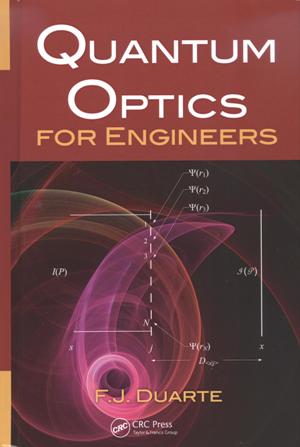
Quantum Optics for Engineers includes: some 190 figures, numerous tables, some 1000 equations, many worked out examples, about 100 problems, a large number of archival references, in about 472 pages. A corrigenda is available in PDF form.
Call number at Library of Congress: QC446.2 .D83 2014
Quantum Optics for Engineers: corrigendum
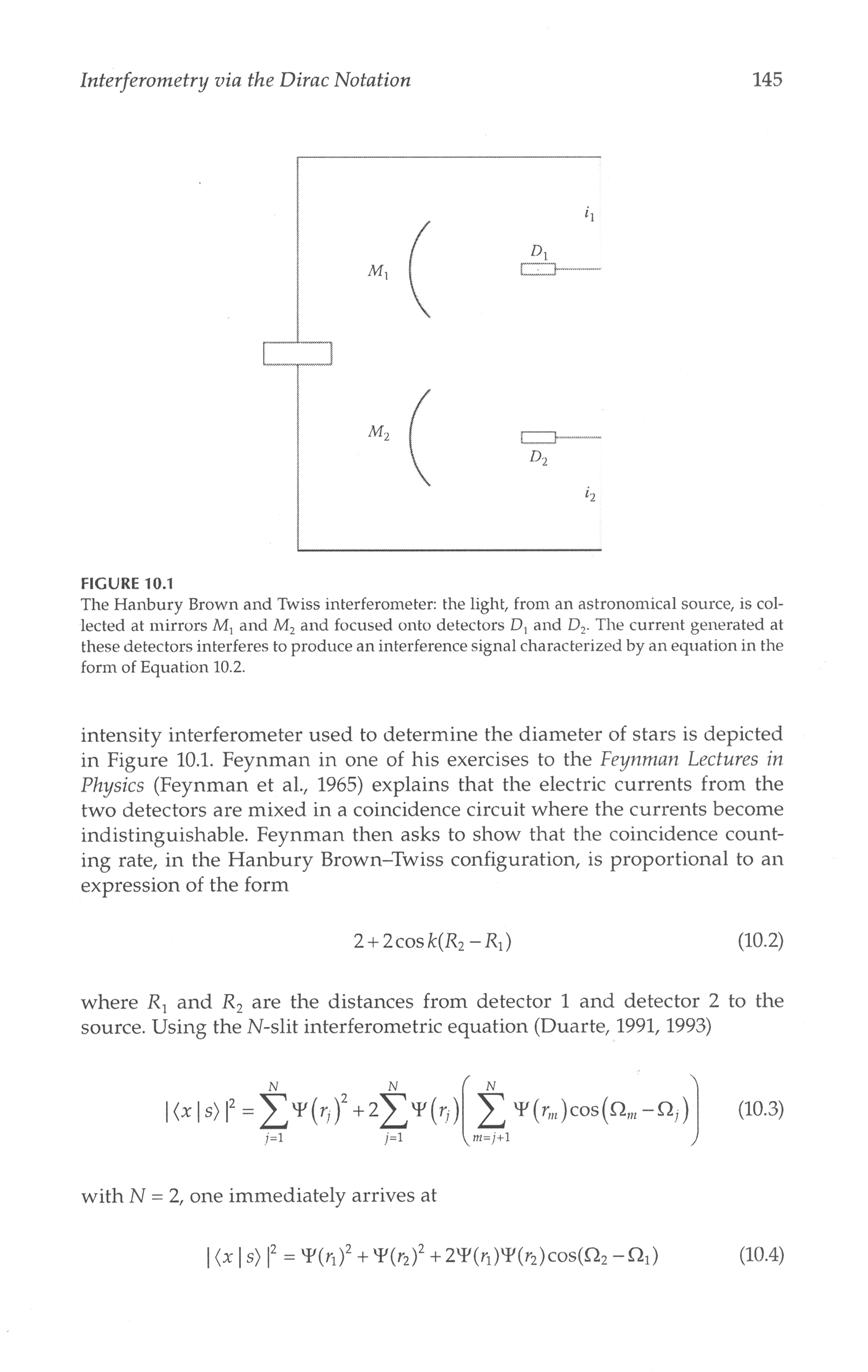
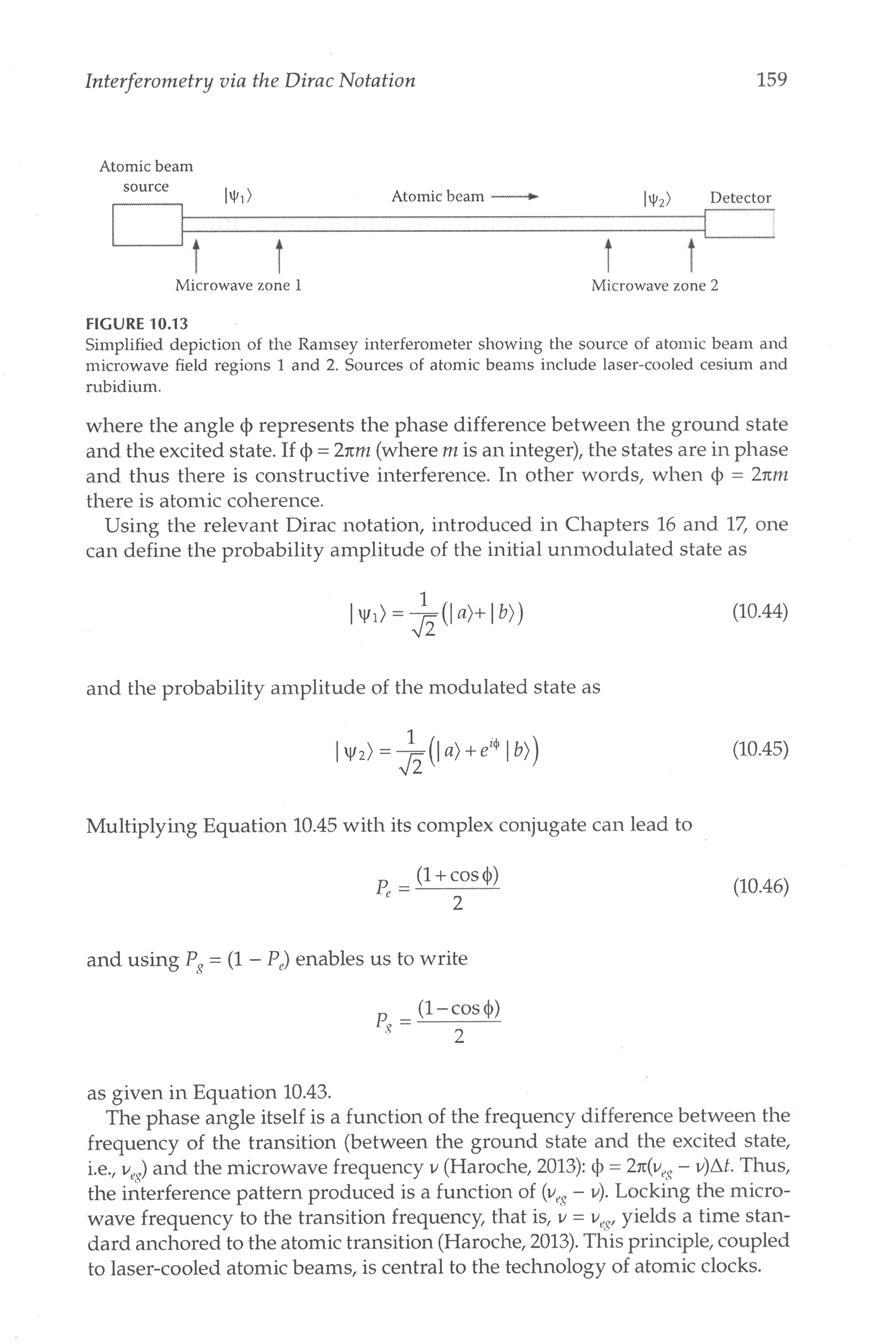
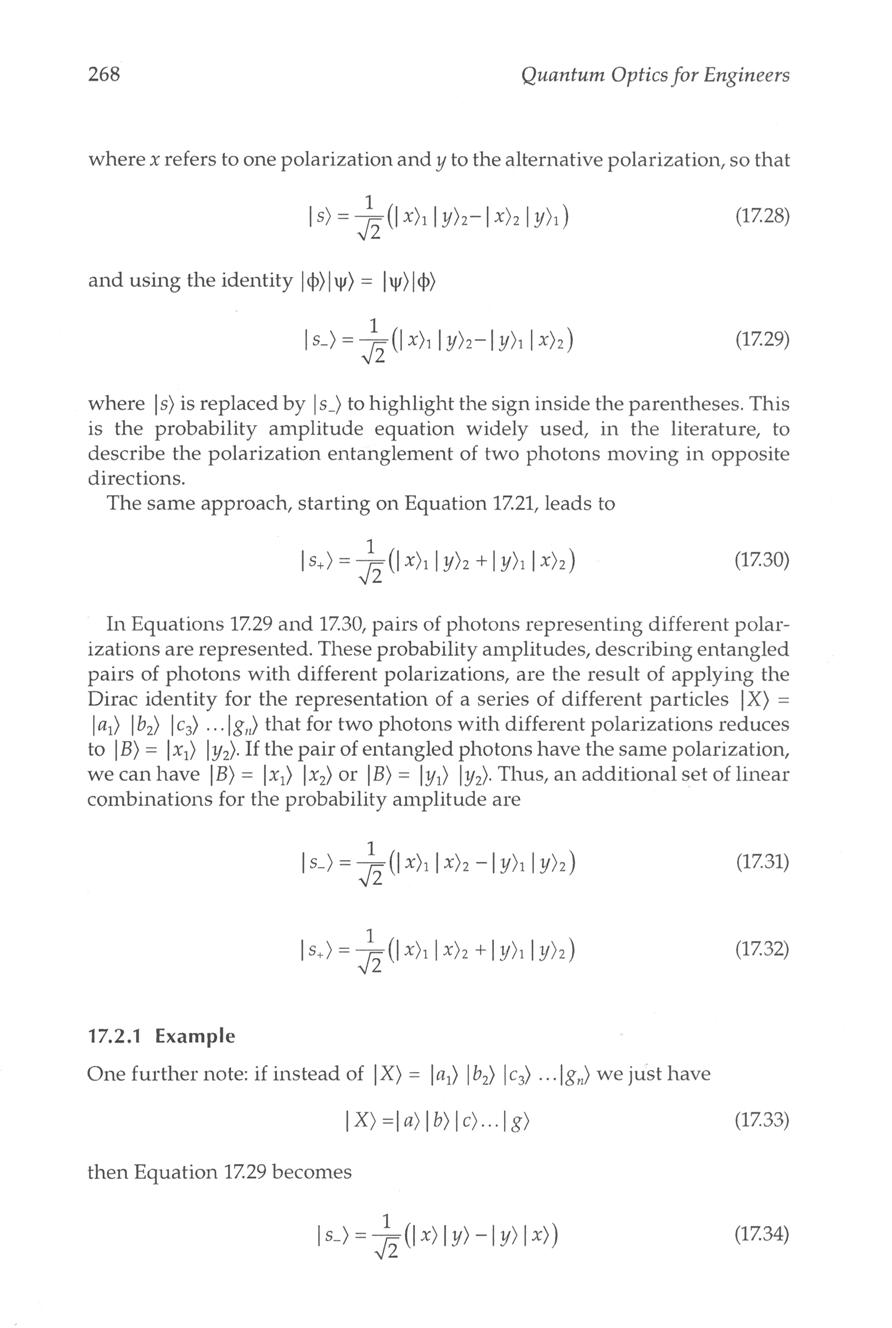
"Duarte's book is a welcome addition to the family of optics texts because he stresses fundamental connections between classical and quantum optics. His review of the bedrock theory and experiments of several of the founders of quantum physics provides an instructive transition to recent developments in quantum optics, such as photon entanglement. Perhaps the most appealing aspect of this book is the treatment of classical optical concepts and phenomena in terms of a quantum formalism...Both graduate students and the experienced researcher will find this treatment of quantum optics to be illuminating and valuable...I look forward to having a copy in my personal library."
Professor J. Gary Eden, Electrical and Computer Engineering, University of Illinois
"Quantum Optics for Engineers is an original and unique book that describes classical and quantum optical phenomena, and the synergy between these two subjects, from an interferometric perspective. Dirac’s notation is used ... [to] provide a lucid explanation of quantum polarization entanglement. The book will serve engineers with a minimum knowledge of quantum mechanics ... to understand modern experiments with lasers, optical communications, and the intriguing world of quantum entanglement."
Professor Ignacio E. Olivares, Universidad de Santiago de Chile
"Quantum Optics for Engineers provides a transparent and succinct description of the fundamentals of quantum optics using Dirac’s notation and ample illustrations. Particularly valuable is the explanation and elucidation of quantum entanglement from an interferometric perspective. The cohesiveness provided by the unified use of Dirac’s notation, emphasizing physics rather than mathematics, is particularly useful for those trained in engineering. This will be a valuable asset to any optical engineer’s library."
Anne M. Miller, RR Donnelley, USA
"This book is a concise and comprehensive presentation of numerous fundamental concepts related to the light nature and its interaction with matter. A very structured and logical route reveals step by step the rigorous theory of quantum optics. To some extent, the whole project can be fairly defined as unique. One of the heaviest tools in quantum optics, operator representation, is introduced in a very clear and straightforward way. Nature foundations and rather complicated mathematical tools are brought in a very elegant manner such that readers suddenly find themselves as experts in areas they would consider untouchable magic. The intriguing world of quantum entanglement is revealed via many practical examples."
Professor Sergei Popov, Royal Institute of Technology, Sweden
Aguirre Gomez J. G., Aldag H. R., Allaria E., Anisimova E., Aspect A., Badurek G., Baer T., Baltakov F. N., Barbieri C., Barnes N. P., Bass I. L., Baving H. J., Beck R., Bell J. S., Bennett C. H., Bennett J. M., Bennett H. E., Benson S. V., Berger J. D., Berglund A. J., Bernhardt A. F., Bessette F., Black A. M., Blauensteiner B., Bleuler E., Bohm D., Bohr N., Born M., Bradt H. L., Brassard G., Braverman B., Bobrovskii A. N., Brito Cruz C. H., Brouwer W., Brune M., Butcher P. N., Byer R. L., Capasso F., Caro R. G., Chen H., Chen L., Cho A. Y., Chutjian A., Cirac J. I., Clauser J. F., Conrad R. W., Corzine S. W., Corson D., Costela A., Cotter D., Crépeau C., Csatári M., Cuadra J. A., Dalitz R. H., de Broglie L., DeLabachelerie M., Delfyett P. J., De Martini F., Demmler S., Demtröder W., Deutsch D., Diels J-C., Dienes A., Dietel W., Dinklage A., Dirac P. A. M., Duarte F. J., Dyson F. J., Ehrlich J. J., Einstein A., Ekert A. K., Erhart J., Everett P. N., Faist J., Falkenstein W., Fan Y. X., Favre F., Ferincz I. E., Feynman R. P., Flamant P. , Flanders H., Fleeming M. W., Fontaine J. J., Fork R. L., Fort J., Friberg A., Fujimoto J. G., Fürst M., Ganiel U., Garcia-Moreno I., Gavrilovic P., Gill P., Glashow S. L., Gobby C., Gordon J. P., Grangier P., Grebing C., Haag G., Hackel R. H., Hagemann C., Haken H., Hammond P., Hanbury Brown R., Hanna R. C., Hänsch T. W., Hardy A., Hargrove R. S., Haroche S., Harrison J., Harvey K. C., Hasegawa Y., Haub J. G., He Y., Heiner Z., Heisenberg W., Herbst R. L., Herbst T., Hertz H., Herzberg G., Hibbs A. R., Hillman L. W., Hogan F., Hollberg L., Holt R. A., Honna K., Hooker S., Hornbostel J., Horne M. A., Hugi A., Hullman J. D., Hutchinson, A. L., Itano W. M., James T. C., James R. O., Jenkins F. A., Jennewein T., Jensen C., Jones R. C., Johnson M. J., Johnston T. F., Jeong Y., Jordan P., Jordan T. F., Jozsa R., Judd B. R., Kafka J. D., Kaiser D., Kan T. K., Kasday L. R., Kaslin V. M., Kessler T., Kildal H., Kim Y-H., King B. E., Kintzer E. S., Klebniczki J., Kleinpoppen H., Kner P., Kocsis S., Koer J., Kogelnik H., Korfhage R. R., Kovács A. P., Kropatschek S., Kubota H., Kulik S. P., Kurdi G., Kwiat P. G., Lamb W. E., Landau L. D., Laudenslager J. B., Legero T., Leighton R. B., Levenson M. D., Liao L. S., Lifshitz E. M., Lindenthal M., Lokajczyk T., Loree T. R., Lorrain P., Ma X., Mandel L., Maiman T. H., Makarov V., Marowski G., Martin M. J., Martinez O. M., Maulini R., McDermid I. S., McKee T. J., Meaburn J., Mech A., Meekhof D. M., Mermin N. D., Meyenburg M., Michelson A. A., Miller A. M., Mirin R. P., Monroe C., Mooradian A., Morita T., Moulin C., Moulton P. F., Moyal J. E., Munz M., Nagaola S., Naik D. S., Nair L. G., Naylor, W., Neumann G., Newton I., Olivares I. E., Ömer B., Orr B. J., Osvay K., Ozawa M., Pacala T. J., Paine D. J., Pang L. Y., Patterson S. P., Pasternack S., Pelliccia D., Penzkofer A., Perdigues J., Peres A., Peterson C. G., Peterson O. G., Petrash G. G., Piper J. A. , Planck M., Podolsky B., Poicaré H., Popov S., Price J. J., Pryce M. H. L., Raimond J-M., Ramsey N. F., Rarity J., Rasmussen P., Ravets S., Riehle F., Robertson H. P., Robertson J. K., Robson B. A., Roger G., Rosen N., Rudolph W., Russell S. D., Salam A., Saleh B. E. A., Salvail L., Salvatore R. A., Sands M., Sargent M., Sastre R., Schäfer F. P., Scheidl T., Schettini V., Schiff L. I., Schimitschek E. J., Schmidt W., Schmitt-Manderbach T., Schröder T., Schrödinger E., Schumacher B., Schwinger J., Sciarrino F., Scully M. O., Selleri F., Shaknov I., Shalm L. K., Shan X., Shand M. L., Shank C. V., Shay T. M., Shields A. J., Shimony A., Sias C., Siegman A. E., Silfvast W. T., Singer P., Sirtori C., Sivco D. L., Smilanski I., Smolin J., Snyder, H. S., Sodnik Z., Sponar S., Srinivasan B., Steel W. H., Sterr U., Stevens M. J., Strome F. C., Sugii M., Suluok G., Sze R. C., Tang K. Y., Taylor T. S., Tavella F., Teich M. C., Tenenbaum J., Teschke O., Tiefenbacher F., Tomonaga S., Treves D., Trojek P., Tuccio S. A., Twiss R. Q., Uenishi Y., Ursin R., Vaeth K. M., van Kampen N. G, Varmette P. G., Volze J., von Neumann J. , Voumard C.,Wallace R. P., Wallenstein R., Walling, J. C., Wang D., Ward J. C., Webb C. E., Weier H., Weinberg S., Weinfurter H., Wellegehausen B., Wheeler J. A., Whinnery J. R., White A. G., White H. E., White R. T., Wilhelmi B., Willett C. S., Wineland D. J., Wittmann B., Wolf E., Wollnik H., Wootters W. K., Woodward B. W., Wu C. S., Wyatt R., Yakushev O. F., Yang T. T., Yanhua Shih Y, Yankelevich D. R., Yariv A., Ye J., Yeh C-H., Yuan Z. L., Zeilinger A., Zhang D., Zoller P., Zorabedian P.


